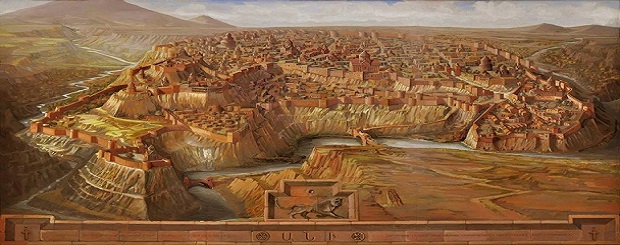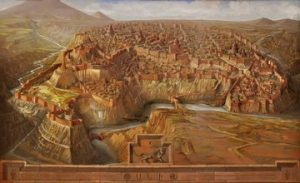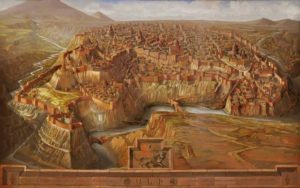
Art-A-Tsolum – Armenia in The Period of the Bagratid Kingdom.
Art-A-Tsolum – PREVIOUS ARTICLE:
September 29, 2018 – Antiquities, History:
In 851, the Armenian prince Bagrat Bagratuni, his sons Ashot and David Bagratuni, and Prince Sasun John Hutevtsi were in captivity. The place of the Armenian prince was occupied by Sparapet Smbat Bagratuni Ablbas (852-855). However, in 855, he was also arrested and exiled to Samaria.
The son of Smbat, Ashot Bagratuni, achieved the withdrawal of Arab troops from Armenia and in 855 the Arab caliphate recognized him as the king of Armenia. In 859, the caliphate gave Ashot Bagratuni powers to collect taxes.

In 861, after the assassination of Caliph Mutawakil and the aggravation of the new struggle for the throne, some countries separated from the caliphate. With the intention to preserve its influence in Armenia and the Transcaucasus, the Caliphate recognized Ashot Bagratuni as Armenian, Georgian and Aghvan prince in 862, giving him the right to collect taxes.
In the same year, Ashot Bagratuni transferred the Armenian Defense (sparapetutyun) to his younger brother Abas Bagratuni. In 863, the Arab army, led by Amir Jahap, invaded Arsharunik in order to seize of Bagratids possession.
However, Sparapet Abas with the 40,000-strong army completely defeated the enemy. In the 860’s. Ashot Bagratuni regulated the government bodies, under his authority he united influential princely houses of Armenia and Transcaucasia, led a wise domestic and foreign policy.
During the general council of Armenian princes and high-ranking clergymen in 869 Ashot Bagratuni was proclaimed an Armenian king. In 875, Ashot Bagratuni uncovered the conspiracy against yourself of the Arab vicegerent Ahmad with the Armenian princes. Ashot arrested Ahmad, disarmed the Arab army, and drove out of the country the vicegerent.
Armenia, reached independence and embarked on the path of development, and soon attracted the attention of Byzantium. The founder of the Macedonian (Armenian) Imperial House, Vasily I (867-886) was one of the first who tried to find an ally in Armenia in the struggle against the Caliphate.
However, Ashot Bagratuni, having established a kinship relationship with Vasil I, diplomatically retained neutrality between the warring sides. Caliph Mutavakil, in order to prevent the Armenian-Byzantine rapprochement and location of Ashot Bagratuni, in 855 recognized him as “Armenian and Georgian King”.
The crown of the Armenian king was also recognized by Emperor Vasily I. After these events, the Bagratid kingdom extended to most of Armenia, not counting a few western regions attached to Byzantium (Little Armenia, High Armenia, Sophena) and some southern areas attached to the Caliphate viceroyalty of Zazir.
According to the testimony of Armenian and Arab historiographers during the reign of Ashot I Bagratuni (885-890), the borders of the Armenian state in the south included most of the provinces of Korchay and Akhdznik up to Zazira, in the southeast reached Atropatena, in the east – to Partava, on west to Sophena and High Armenia, in the north-west up to the land of Egerats, and in the north – to the Caucasian mountain range and Alanats dur (Doors of Alans).
The Georgian princes of the Bagratun family also obeyed King Ashot. The Georgian princes of Bagratuni’s family and the ruler of Hayots Arevelk (Artsakh, Utic) also obeyed King Ashot. Atrnersekh Bagratuni in Georgia (Iberia) and Amam Bagratuni in Artsakh-Utic.
In order to strengthen the northern borders of the united Armenian and Georgian kingdoms, Ashot I organized a campaign in 887 to the Main Caucasian Range. On the way, he suppressed the local irreconcilable tribes, and the king of the country, Yegherats, forced to accept his domination.
The hereditary son of Ashot I, Prince Smbat, suppressed the disobedience of the princes of Gugark and Utica and subdued them to the Bagratids. Then Ashot I began building the capital Bagaran, improving the country’s defensive system and strengthening the army (40 thousand cavalry), thereby leaving a stable and developing state to his son Smbat.
After the death of Ashot of Bagratuni on the throne of the Armenian kingdom succeeded each other, Smbat I Bagratuni, Ashot III Zheleznyi, Ashot III the Merciful, Smbat II Tieserakal (“Ruler of the Universe”), followed by Gagik I Bagratuni, after the death of which was simultaneously ruled by his sons, Hovhannes Smbat and Ashot IV, and then Gagik II Bagratuni. The kingdom of the Bagratids fell in 1045.
by Katvalyan M.
Բագրատունյաց թագավորությունը Հայաստանում (I Մաս)
Բագրատունյաց թագավորությունը Հայաստանում.(II Մաս) Զաքարյան իշխանապետությունը.

allinnet.info/antiquities/armenia-in-the-period-of-the-bagratid-kingdom/?
